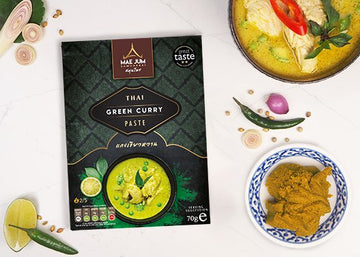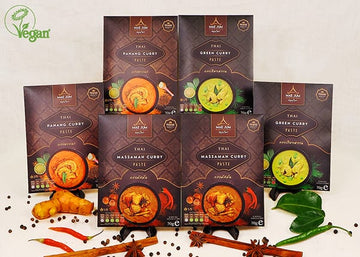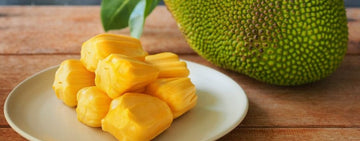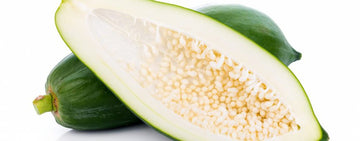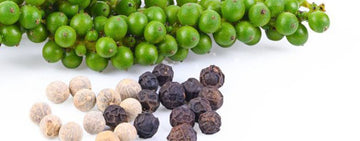All You Need to Know About Jackfruit: A Versatile, Nutritious Fruit for Your Kitchen
Welcome to Mae Jum’s blog, where we explore the wonderful world of jackfruit! This tropical fruit, which grows on trees up to 25 metres tall, is one of the most fascinating and versatile foods you can add to your culinary repertoire. With individual fruits weighing up to a massive 35kg, jackfruit is the largest fruit that grows on trees and is popular across Southeast Asia, where it thrives thanks to its long, nine-month growing season. While the ripe fruit is prized for its sweetness, young or unripe jackfruit has recently gained attention in Western kitchens as a fantastic meat substitute for various recipes.
In this blog, we will dive deep into everything you need to know about jackfruit, from what it is and where to buy it, to how you can prepare and cook it, and the numerous health benefits it offers.
What is Jackfruit?
Jackfruit is a tropical fruit that is native to Southeast Asia and is the national fruit of Bangladesh. It is commonly grown in countries such as Thailand, Indonesia, and India, among others. Jackfruit is often compared to durian because of its size, oblong shape, and green, prickly exterior. However, jackfruit tends to be larger, and while durian has a strong, distinctive smell, jackfruit’s scent is more mild, particularly when unripe.
Inside the thick green shell of the jackfruit are large, pale yellow pods, which are attached to the core of the fruit. The pods are surrounded by a stringy layer, and each pod contains a seed. When ripe, the flesh of the jackfruit is sweet and tropical in flavour, often compared to pineapple or mango. On the other hand, unripe jackfruit, also called young or green jackfruit, has a neutral taste and a texture that makes it a great substitute for meat in savoury dishes. When cooked, unripe jackfruit can mimic the texture of pulled pork or shredded chicken, making it a favourite ingredient in plant-based cooking.
There’s a common misconception that jackfruit seeds are toxic, but that’s not the case. In fact, the seeds are edible when cooked and have a slightly nutty, chestnut-like flavour.

Where to Buy Jackfruit?
If you live outside of Southeast Asia, finding fresh jackfruit can be challenging, but not impossible. A whole jackfruit or even a half jackfruit can be quite expensive due to its large size and the shipping costs involved. In the UK, fresh jackfruit can cost around £12 per kilogram, but smaller portions are available at Asian grocery stores and speciality markets. A 250g portion of fresh ripe jackfruit typically costs between £6 and £7, while unripe jackfruit portions are slightly less expensive, ranging from £4.30 to £5.
When buying fresh ripe jackfruit, the smell is a key indicator of its ripeness. The stronger the aroma, the riper the fruit. However, if the jackfruit has dark spots on the exterior, it may be overripe or improperly stored, so it’s best to avoid fruits with these blemishes.
For those who can’t find fresh jackfruit, canned, dried, and frozen forms are readily available in shops and online. Canned jackfruit is an inexpensive and convenient option, with unripe jackfruit in brine (ideal for savoury dishes) costing around £1.75 for a 565g can (280g drained weight), while ripe jackfruit in syrup (for sweet dishes) costs approximately £2.30 for a similar-sized can.
How to Prepare and Cook with Jackfruit
Preparing a whole green jackfruit requires some effort, but the results are well worth it. If you’re working with fresh unripe jackfruit, be aware that it releases a sticky, latex-like substance when cut, so it’s important to protect your hands and utensils. Wearing gloves is a good idea if you have a latex allergy, and coating your hands and knife with oil can help prevent the sticky latex from adhering to them.
Once you’re ready, lay down some newspaper or parchment paper to cover your work surface. Slice the jackfruit in half with a sharp knife, then continue cutting it into large chunks, leaving the skin on. The fruit can be boiled or cooked in a pressure cooker to soften the flesh. If you’re boiling the jackfruit, it will take about 45 minutes, while a pressure cooker will reduce the cooking time to 10 to 15 minutes.
After cooking, drain the water and let the jackfruit cool. Once it’s cool enough to handle, remove the skin and separate the flesh from the seeds. The flesh can be shredded or sliced depending on how you plan to use it, and the stringy part between the pods and skin is also edible, so be sure to keep that. You can freeze the cooked jackfruit at this stage if you don’t plan to use it all immediately.

Cooking with Jackfruit
One of the most popular ways to use unripe jackfruit is as a meat substitute in vegan or vegetarian dishes. The neutral flavour of young jackfruit allows it to absorb the seasonings and spices around it, making it a versatile ingredient for everything from jackfruit tacos to pulled jackfruit sandwiches.
In Thai cuisine, jackfruit pairs beautifully with rich, flavourful curries. For example, Jackfruit Thai Green Curry is a delicious and satisfying plant-based option. The shredded jackfruit mimics the texture of meat, while the bold flavours of the curry paste and coconut milk create a dish that’s hearty and full of flavour.
Ripe jackfruit, on the other hand, can be eaten fresh or used in desserts. Its sweet, tropical taste makes it a fantastic addition to fruit salads, smoothies, or desserts like jackfruit ice cream. When ripe, the fruit has a similar flavour to mango or pineapple, adding a burst of sweetness to any dish.
Don’t Throw Away the Seeds!
Many people discard the seeds when preparing jackfruit, but they’re actually quite delicious and nutritious. Jackfruit seeds can be boiled, roasted, or even turned into flour. When roasted, the seeds develop a flavour similar to chestnuts or pumpkin seeds, making them a great addition to salads, hummus, or as a snack on their own.
Roasting jackfruit seeds is simple—just boil them for about 10 to 15 minutes, then roast them in the oven until they’re golden brown. Once cooked, you can enjoy them whole or remove the outer skin before eating.
In Thai cuisine, jackfruit is commonly used in desserts due to its sweet, tropical flavour when ripe. The ripe yellow flesh of jackfruit adds a unique, fruity taste similar to pineapple and mango with a pleasant chewy texture to various traditional sweets.

A traditional Thai dessert featuring jackfruit is Khanun Loy Kaew, or jackfruit in syrup. Ripe jackfruit flesh is simmered in a light sugar syrup infused with pandan leaves or jasmine to enhance the flavour. Once cooked, the jackfruit becomes even softer and sweeter, and the syrup adds a delicate floral note. This simple dessert is often served chilled as a refreshing treat, especially in Thailand’s hot climate.
Jackfruit is often included in Ruam Mit, a colourful Thai iced dessert made from a variety of tropical fruits, jellies, and sweetened coconut milk. Ripe jackfruit slices provide a chewy, sweet element, adding to the medley of textures and flavours. Ruam Mit is often served with crushed ice, making it a perfect dessert for hot days.
Health Benefits of Jackfruit
Jackfruit is not only versatile in the kitchen but also incredibly nutritious. Whether eaten ripe or unripe, this fruit provides a wide range of vitamins and minerals that can benefit your overall health.
1. Rich in Vitamins
Jackfruit is packed with vitamins A and C, which are essential for maintaining a healthy immune system, skin, and vision. Vitamin C also acts as a powerful antioxidant, protecting your body from free radical damage and reducing inflammation.
2. A Good Source of Minerals
Raw jackfruit contains calcium, iron, and magnesium, all of which play important roles in maintaining strong bones, supporting muscle function, and improving circulation. Jackfruit is also high in potassium, which helps regulate blood pressure and promotes heart health.
3. High in Fibre
Jackfruit is a great source of dietary fibre, which aids digestion and helps regulate bowel movements. The fibre content in jackfruit can also help you feel fuller for longer, making it a valuable addition to a balanced diet.
4. Contains Protein
While jackfruit is not as high in protein as some other plant-based foods, it still provides a decent amount of protein, particularly in its raw form. This makes it a good option for those following a vegetarian or vegan diet who are looking for alternative sources of protein.
5. Antioxidants and Isoflavones
Jackfruit is rich in antioxidants and isoflavones, which can help protect against certain types of cancer, particularly hormone-dependent cancers. These compounds neutralise free radicals in the body, which can otherwise damage cells and lead to chronic illnesses.
Conclusion: Jackfruit – A Nutritious, Versatile Ingredient
Jackfruit is truly a remarkable fruit, offering both culinary versatility and a wealth of health benefits. Whether you’re incorporating unripe jackfruit into savoury dishes as a meat substitute or enjoying ripe jackfruit in sweet desserts, there are countless ways to enjoy this tropical fruit.
Though it may take a bit of effort to prepare fresh jackfruit, the results are worth it. And with canned and frozen options readily available, it’s easier than ever to experiment with jackfruit in your cooking. From jackfruit tacos to Thai curries, the possibilities are endless!
So next time you’re at an Asian grocery store or browsing online, consider picking up some jackfruit and trying out one of Mae Jum’s delicious jackfruit recipes. Whether you’re cooking for yourself or entertaining guests, jackfruit is sure to impress with its unique texture, flavour, and nutritional profile.

If you enjoyed reading our ‘get to know: Jackfruit’ blog post, please give this blog a star rating and comment if you are a fan of jackfruit or would love to try this fruit one day! Check out our blog for more interesting articles like this and subscribe for new recipes and posts. Always stay connected and follow us on Instagram and Facebook!
